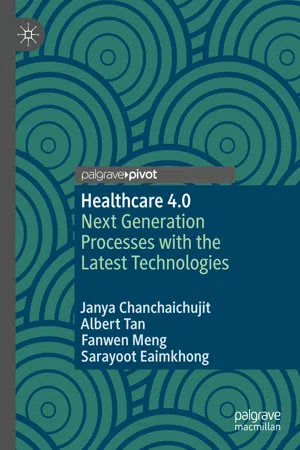1.1 Introduction
New opportunities and challenges emerge in an industry as a result of customer demand and the desire for advanced technology to further enhance sophisticated technological services. Such transformation promotes new context configurations, new environments and new motivations which will eventually impact upon a company’s performance. Today, technical advancements and innovations are gaining serious importance in several industries such as the biotech industry, IT industry and automotive industry. These industries are incorporating new technologies which make use of automation and provide intelligent solutions. These transformations are the precursors to the rapid changes which are leading us towards a new industrial revolution, or Industry 4.0 as it is known. This “revolution” will have an industry-wide impact (Tjahjono, Esplugues, Ares, & Pelaez, 2017).
Society itself is being influenced by this revolution. Our general operational structure, man–machine interaction optimization, economic views and patterns, and other significant circumstances are all affected. Industry 4.0 enhances the ability to accurately interpret and recognize progressions, along with an awareness and understanding of market trends. The organizational structure of a firm can be streamlined and made more cohesive by utilizing new discoveries in Industry 4.0. This revolution is promoting new models such as social networks, additive manufacturing, collaborative innovation, digital platforms and a shared economy that initiates change in organizations. Production in the manufacturing industry has been completely modernized and automated. Industry 4.0, with its technical advancement, has not only promoted improvements but in itself is a concept that promotes transformation (Lu, 2017).
There has been a great deal of research into Industry 4.0 and its benefits, challenges and opportunities with regard to the healthcare industry. The internet has been a revolutionary technology for the healthcare sector and it has helped in optimizing the entire supply chain and provided more detailed patient outcomes. However, incorporating Industry 4.0’s core principles into healthcare practices is still not widespread enough to have created the transformation that is possible.
Industry 4.0 is not just a technical advancement; it is a profound concept that can enhance the performance of any industry. The six core principles of virtualization, modularity, interoperability, decentralization, service orientation and real-time capabilities constitute the concepts contained within Industry 4.0. Industry 4.0 core principles are driven by emerging technologies such as blockchain, Internet of Things (IoT ), big data and Artificial Intelligence (AI) (Manogaran, Thota, Lopez, & Sundarasekar, 2017). The main aim of this book is to demonstrate the benefits of implementing Industry 4.0 in healthcare services and to recommend a framework to support this implementation.
1.2 Industry 4.0
In 2011, German manufacturing industries were strengthening their competitiveness in the sector by promoting a new concept, with the help of pioneers from different fields such as politics, academia and business. This concept was proposed at the Hanover Trade Fair 2011 as Industry 4.0. The concept was widely supported by the German government with the view that Industry 4.0 would develop into a high-level competitive strategy in the future.
The “virtual marketplace” is expected to influence the connection of the physical world (people, products, machines and systems) to a constant virtual world. In this way, service platforms and software-based systems will play a significant part in future manufacturing processes. These virtual connections are the optimal way of analysing and providing data that supports the communication between product and machine. In other words, virtual connection is the process of connecting physical and digital processes to “smart” products.
1.2.1 Key Components of Industry 4.0
The fundamental components of Industry 4.0 are cyber-physical systems (CPS ) and Internet of Services (IoS ). These components are equipped with actuators and sensors which help in effective communication and support factories to work autonomously and in a decentralized way (Zezulka, Marcon, Vesely, & Sajdl, 2016).
Cyber-Physical Systems (CPS)
CPS are fundamental elements of Industry 4.0 that connect the physical and virtual world. CPS are characterized by remarkable coordination of distributed ledgers and internet services. In other words, the systems that connect physical processes with computations are called cyber-physical systems, or CPS. Computation is influenced by physical processes such as feedback loops, embedded networks and computers, and physical process controls (Poovendran, 2010). The physical process is also influenced by computation. High-level transparency, efficiency, surveillance and control in the operations process are a few of the noteworthy advantages of CPS. CPS consist of two parallel networks such as cyber networks and physical networks, and constitute communication linkages between these networks. The cyber network includes intelligent controllers while a physical network incorporates infrastructure of manufacturing. Using several controls, actuators, communication devices and sensors, CPS connect these two networks (Garibaldo & Rebecchi, 2018).
Internet of Things (IoT)
The internet has allowed technical advancements and had an unprecedented impact on both communication systems and data-sharing systems. Moreover, it has facilitated the exchange of and access to real-time data from any place in the world and at any time. It also enhances the coordination required between the customer, the supplier and the company, along with the interaction of man and machine. IoT has served as an Industry 4.0 initiator since the 1990s (Gubbi, Buyya, Marusic, & Palaniswami, 2013). Smart products can allow us to overcome or cut across the traditional boundaries of a product, providing greater reliability, new functionality, expanded opportunities and high-level product utilization. IoT promotes an environment where every individual can be connected to web service provided by smart technology, which is self-managing, self-aligning and self-organizing anywhere and at any time. IoT constitutes the most dominant and conservative technology that can stimulate numerous opportunities for economic growth (Wortmann & Flüchter, 2015).
Internet of Services (IoS)
Concerning the idea of a “service society” and IoT, web-orien...
